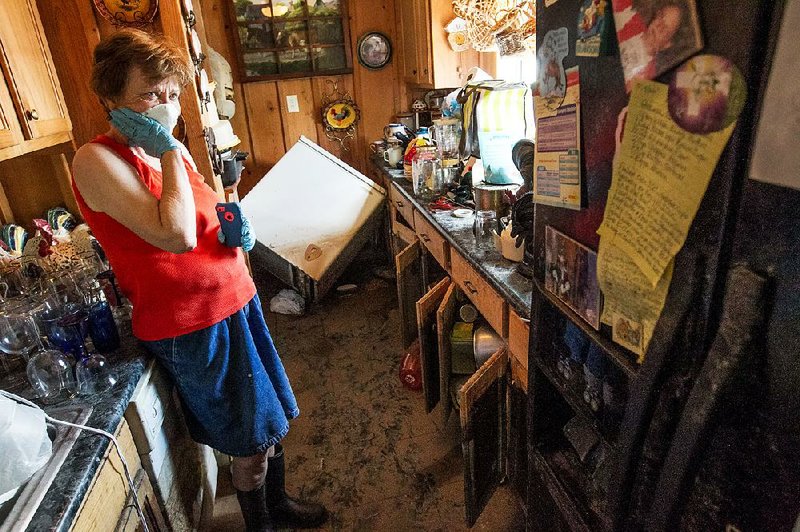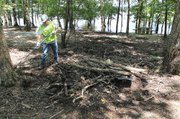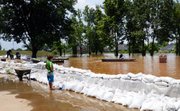After a helicopter tour of submerged fields and washed-out land, Gov. Asa Hutchinson said Tuesday that he will work to secure federal disaster relief to help with the untold damage to crops, livestock and homes inflicted by the most severe flooding in southwest Arkansas in more than 20 years.
From nearly a half-mile in the air as the helicopter cut west through a clear morning sky, Hutchinson peered down and watched as the sloping sea of green fields and forests ribboned by blue streams and dirt roads gave way to acres upon acres of milky-brown standing water.
"It's about as eye-opening as you can imagine," Hutchinson said. "Much more informative, really, than even being on the ground."
The governor said his visit to Little River and Miller counties, two of the hardest-hit by flooding over the past few weeks, helped him appreciate the depth and the breadth of the floodwaters' reach.
"There's no doubt that we need it," Hutchinson said of federal assistance. "It's a question of whether the entire disaster will be enough to qualify for federal assistance. I think we can make the case."
Hutchinson has already asked U.S. Agriculture Secretary Tom Vilsack for 37 of the state's 75 counties to be declared agricultural disaster areas, which would make it possible for farmers and ranchers to seek emergency loans.
"That's not going to cover all the loss," Hutchinson said.
Officials in Miller and Little River counties have yet to put a dollar figure on the far-reaching damage done by the flooding, which started in early May.
Arkansas Department of Emergency Management Director David Maxwell said it would be another week or two before officials can complete preliminary assessments of the damage. Afterward, state officials can put together a request for assistance from the Federal Emergency Management Agency.
After landing on a closed section of U.S. 71 outside of Ogden just a football field away from a submerged section of highway, Hutchinson met and talked with Little River County emergency officials.
He also met cattle rancher Brett Fawcett, who gave the governor a personal tour of his waterlogged land.
"This road here, I drove my tractor here ... it was 4 feet deep here," Fawcett said. "Acres and acres ... every bit of it."
Fawcett's wife, Teresa, said at least 800 of their 818 acres were flooded when the Red River, nearly a mile from their property, spilled over its banks.
"It was unreal the amount of water," she said. "We never imagined anything like it could happen."
They moved their 454 head of cattle to a raised 5-acre plot. With no grass, it's costing them about $700 a day to feed the animals, she said.
While navigating county roads in his four-wheel drive pickup, Fawcett looked for traces of greenery on his land, hopeful that there might be patches that could support grazing.
"A cattle rancher is a grass farmer. We're just using cattle to harvest our crop," Fawcett said. "But if you don't have grass, and you've got cattle, you're in trouble. ... If it takes it all, you're out of business."
In the Miller County town of Garland, which was briefly evacuated over concerns a levee would fail, Hutchinson said the personal toll the floods have taken on communities was striking. He commended those who helped one another make it through the difficulties, including volunteer firefighters, sheriff's deputies and neighbors.
Levees like those in Garland were mostly built by the Army Corps of Engineers and are maintained by local levee boards, Maxwell said. The state has been barred since the 1930s from involving itself in the levees' upkeep.
There are no uniform standards or practices for the levee boards, most of which were created after the great 1927 flood, Maxwell said.
"Some of them are active, some haven't been," Maxwell said. "Some collect money, some don't. ... There's a mishmash all the way across."
Hutchinson said reports of sand boils threatening a levee in Miller County and a 150-foot break in a Perry County levee raised questions about the management of the state's levees. Legislators are expected to discuss levee maintenance at a committee meeting later this month.
"We need to be alert to problems earlier than when the floods happen," Hutchinson said. "We need to increase the inspections on our levees and the nonflood work-time on our levees."
While water-covered roads prevented travel to some areas near the Red River, officials assessed flood damage on the ground in areas they could access Tuesday.
"We've got a lot of culverts out, potholes and washouts," said Danny Ormand, the coordinator for the Lafayette County Office of Emergency Management.
Ormand and Lafayette County Judge Mike Rowe met with FEMA representatives Tuesday to conduct preliminary damage assessments and begin determining the cost of flood damage to the county.
Ormand said the county spent $100,000 in rescue efforts alone. He said when water recedes from county roads, officials will then be able to evaluate the amount of damage inside the Red River levees.
The Red River fell to 28.8 feet Tuesday evening at Fulton. Flood stage there is 27 feet.
"We hope by the end of the week we can get where we need to go," Ormand said.
In Perry County, officials said the flooded Arkansas River forced them to close 24 county roads last week. All but one is open now.
"Once the water receded, we saw we had a lot of washed-out spots," a Perry County Road Department employee said.
Rick Fahr, a spokesman for the state Emergency Management Department, said calls from counties about damage are starting to roll in.
"The rivers are on a downhill slide finally, and we're just now getting the calls," Fahr said. "A lot of counties are seeing road damage."
In Pine Bluff, city Treasurer Greg Gustek stayed in his home on Riverside Drive during the flooding, watching the Arkansas River gradually rise to a crest of 45.96 feet -- the fifth highest mark recorded for that section of the river.
He said Jefferson County sheriff's deputies patrolled the area during the flooding, both to ensure there was no looting in empty homes and to keep sightseers from creating wakes by driving or boating through the flooded neighborhood.
Gustek lived on the second floor of his home atop a large garage. Water came within an inch of entering the garage last week, he said.
Others weren't so lucky.
"Some had 4 to 6 feet of water in their home," he said. "We have neighbors pulling up carpet and taking drywall out. A lot of homes are ruined. They will have to be gutted, and people will have to start over again."
Gustek said neighbors started returning to their homes Saturday, when the river receded over the road, leaving behind a thick blanket of mud and debris.
He said armies of ants and other odd critters have slithered into his garage to get away from the floodwaters.
"It's heaven here on the river most of the time," Gustek said. "That's why we pay the big bucks to live here. But when the river does come up every once in a while, this is what we deal with."
State Desk on 06/10/2015





